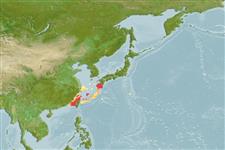Environment: milieu / climate zone / depth range / distribution range
Ecology
Marine; demersal; oceanodromous (Ref. 51243). Temperate; 32°N - 23°N
Western Pacific: Hokkaido to the East China Sea.
Size / Weight / Age
Maturity: Lm ? range ? - ? cm
Max length : 30.0 cm TL male/unsexed; (Ref. 56557); max. published weight: 77.70 g (Ref. 124713)
Commercially cultured in Japan. Juveniles associate with drifting seaweed (Ref. 12114, 12115).
Life cycle and mating behavior
Maturities | Reproduction | Spawnings | Egg(s) | Fecundities | Larvae
Masuda, H., K. Amaoka, C. Araga, T. Uyeno and T. Yoshino, 1984. The fishes of the Japanese Archipelago. Vol. 1. Tokai University Press, Tokyo, Japan. 437 p. (text). (Ref. 559)
IUCN Red List Status (Ref. 130435)
Threat to humans
Harmless
Human uses
Fisheries: highly commercial
Tools
Special reports
Download XML
Internet sources
Estimates based on models
Preferred temperature (Ref.
123201): 21.4 - 24.7, mean 22.7 °C (based on 26 cells).
Phylogenetic diversity index (Ref.
82804): PD
50 = 0.5312 [Uniqueness, from 0.5 = low to 2.0 = high].
Bayesian length-weight: a=0.02818 (0.01755 - 0.04527), b=2.94 (2.80 - 3.08), in cm total length, based on LWR estimates for this species & (Sub)family-body (Ref.
93245).
Trophic level (Ref.
69278): 2.8 ±0.39 se; based on food items.
Resilience (Ref.
120179): Medium, minimum population doubling time 1.4 - 4.4 years (Assuming tm=2).
Fishing Vulnerability (Ref.
59153): Low vulnerability (20 of 100).
Climate Vulnerability (Ref.
125649): High to very high vulnerability (73 of 100).
Nutrients (Ref.
124155): Calcium = 40.3 [15.3, 103.8] mg/100g; Iron = 0.436 [0.167, 1.063] mg/100g; Protein = 17.4 [15.2, 19.7] %; Omega3 = 0.467 [0.195, 1.057] g/100g; Selenium = 14.7 [7.1, 35.6] μg/100g; VitaminA = 9.6 [2.4, 40.2] μg/100g; Zinc = 0.598 [0.401, 0.975] mg/100g (wet weight);
